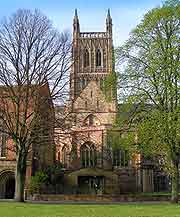Worcester History Facts and Timeline
(Worcester, Worcestershire, England)

To uncover Worcester's history, we need to look back thousands of years to prehistoric times. There's evidence that a settlement was on this site well before the arrival of the Romans.
The diocese of Worcester was founded by an Anglo Saxon churchman known as Archbishop Theodore. The first bishop took up office here in 680 AD and a cathedral was built. Dedicated to St. Peter, there's little surviving evidence as to how it looked. All we know is that it was probably made of stone.
Early Origins
In 961 AD, the post of the Bishop of Worcester was taken up by Oswald, later to become Archbishop of York and then St. Oswald. Unfortunately, in 1041, the town came under attack from Danish forces for not paying its taxes. The cathedral suffered badly during this assault. By 1084, work had started on building a new Norman cathedral on the site and this is the origin of the building we see today.
After the Norman invasion, a new era in history began when William the Conqueror gave the lordship of the manor of Worcester to Urso D'Abitot. During the 12th century, the town saw a number of royal visits, including those made by Henry I and Henry II. In 1263, Worcester was captured by a group of rebellious barons, who took up arms against Henry III and kept him imprisoned here. In 1265, Prince Edward made Worcester his headquarters before the Battle of Evesham.
From the 15th to 18th Century
In the 15th century, the city retained its royal connections, with Henry IV, Henry VI and Edward IV all spending some time here. During the War of the Roses, Henry VII occupied the city. In the 16th century, Worcester became a place of learning, with the reestablishment of the King's School and the founding of Queen Elizabeth's Grammar School.
Worcester played a key role during the English Civil War. The city started off as a Royalist garrison, with most of its inhabitants being loyal to the king. In 1644, it was occupied by Parliamentarians, only to be taken by Royalists a year later, when a triumphant King Charles arrived in the city. In 1646, the city was once again in Parliamentarian hands. Finally, in 1651, the Battle of Worcester took place. King Charles II was defeated, but managed to escape from the city via a building known today as the King Charles Inn. It was to be the final battle in what had a been a prolonged and destructive war.
The 18th century was relatively peaceful in comparison and many fine buildings sprang up in the city. These included the Guildhall, built on the High Street. It was designed by Thomas White, who studied under Sir Christopher Wren. During this period, a porcelain works was set up in the city. In 1788, it was granted a royal warrant and became known as the 'Royal Porcelain Works', being later named 'Royal Worcester'.
19th Century History to the Present Day
The city can lay claim to a number of famous connections and of note, the Lea and Perrins sauce factory was founded here in 1825. Five years later, it started producing its famous Worcester Sauce, which can still be found on shop shelves today. The recipe, however, remains a closely guarded secret. The city's most famous son, Sir Edward Elgar, was born in the suburb of Lower Broadheath in 1857. He went on to become one of Britain's greatest composers, creating such masterpieces as 'Pomp and Circumstance' and the 'Enigma Variations'.
By the mid-19th century, Worcester had become a hub for the whole county. New public buildings at that time included the Shire Hall, the City and County Library, and the Worcestershire Museum. There were banks here, as well as inns, schools and a multitude of shops. At this time, the Cornmarket was the commercial centre of the city.
When the 20th century arrived, Worcester was functioning as an industrial town, with flourishing brick-making and pottery businesses. Gradually, however, service industries and tourism took over. Most new developments in recent years have been retail-related. Between the 1960s and the 1990s, several new shopping centres were built and many areas pedestrianised.
 To uncover Worcester's history, we need to look back thousands of years to prehistoric times. There's evidence that a settlement was on this site well before the arrival of the Romans.
To uncover Worcester's history, we need to look back thousands of years to prehistoric times. There's evidence that a settlement was on this site well before the arrival of the Romans.